Autonomous trucks are transforming the transportation industry with remarkable technological advancements that make driving safer, more efficient, and increasingly sustainable. From AI-powered navigation to predictive maintenance and real-time data processing, these developments are pushing the boundaries of what trucks can do on their own. Here’s a look at fifteen of the most intriguing breakthroughs shaping the future of autonomous trucking.
Contents
Enhanced Sensor Fusion

Sensor fusion technology in autonomous trucks blends data from multiple sources, such as cameras, LiDAR, radar, and GPS, to create a comprehensive and real-time view of the surroundings. This integration improves safety by enabling trucks to detect obstacles and respond to sudden changes. As these systems combine diverse data, they effectively reduce blind spots, enhancing road awareness. Major companies, including Waymo and Aurora, are heavily investing in this area.
Edge Computing for Real-Time Decisions

Edge computing processes data directly on the truck, allowing it to make decisions in real time without depending on remote servers. By eliminating latency, this technology supports instant responses to unpredictable road situations like sudden lane changes. When trucks can process data on-site, they operate more independently, even in areas with limited connectivity. NVIDIA and other tech giants are advancing edge computing to make autonomous vehicles more resilient. This capability is essential for rapid decision-making on the road.
Predictive Maintenance Systems

Predictive maintenance uses AI and machine learning to continuously monitor the truck’s components, identifying wear or potential issues before they become serious. By catching problems early, these systems help prevent costly breakdowns and prolong vehicle uptime. Sensors track the health of parts like engines and tires, allowing fleets to schedule repairs before failures occur. Companies such as Volvo and Daimler are integrating predictive maintenance for smoother operations. This technology promotes efficiency and keeps trucks on the road longer.
Platooning Technology

Platooning technology allows autonomous trucks to travel in a convoy formation, with one lead truck setting the pace and others following closely to save fuel. This arrangement reduces drag, which boosts fuel efficiency and lowers emissions. With reduced lane changes and braking, platooning also improves road safety. Companies like Peloton Technology are pioneering this concept to cut costs for fleet operators. Platooning offers an innovative way to enhance both efficiency and environmental sustainability.
V2V and V2I Communication

Vehicle-to-vehicle (V2V) and vehicle-to-infrastructure (V2I) communication allow trucks to share data with each other and roadside infrastructure like traffic lights. This information exchange helps prevent collisions and smooth traffic flow by offering real-time updates on road conditions. Trucks can receive alerts about obstacles, upcoming congestion, or even changing speed limits. Qualcomm and similar firms are leading the way in developing these protocols. With this advancement, trucks can navigate more safely and collaboratively.
Machine Learning for Complex Environments

Machine learning enables autonomous trucks to adapt to new environments, learning from data to respond better to complex situations. This technology helps trucks navigate unexpected scenarios, such as heavy traffic, construction, or severe weather. Unlike fixed programming, machine learning lets the system become “smarter” over time, refining its reactions based on real experiences. Tesla and Embark are major proponents of machine learning in autonomous vehicles. Such adaptability is crucial for making autonomous trucks viable on diverse routes.
5G Connectivity for Fast Data Transfer

5G connectivity gives autonomous trucks the bandwidth they need for rapid data exchange and real-time monitoring. This high-speed connection supports critical functions like instant rerouting, remote control, and constant updates. By enhancing communication with other vehicles and road infrastructure, 5G allows autonomous trucks to respond faster to changing conditions. Verizon and AT&T are extending 5G networks to support these needs. Such fast, reliable connectivity is pivotal for seamless operations.
Enhanced Cybersecurity Protocols

Cybersecurity has become crucial for autonomous trucks, protecting against potential hacking or data breaches that could compromise safety. With tools like encryption and multi-factor authentication, these trucks secure communication channels and safeguard control systems. Robust cybersecurity ensures that data and vehicle control remain protected from external threats. Cisco and Symantec are among the companies developing specialized cybersecurity solutions for autonomous vehicles. Security measures are essential to protect both vehicle integrity and public trust.
Electric-Powered Autonomous Trucks

Electric autonomous trucks offer a sustainable solution by reducing emissions and reliance on fossil fuels. Tesla’s Semi and Nikola’s electric trucks are examples of models aiming to meet these goals with high-capacity batteries and long-range capabilities. By combining electric power with autonomy, these trucks help address environmental concerns in logistics. Regenerative braking and optimized energy usage further enhance efficiency. This combination of electric and autonomous technologies is leading the way to greener transportation.
Enhanced Remote Monitoring and Control

Remote monitoring lets operators oversee autonomous trucks from centralized control hubs, ready to intervene if issues arise. This capability ensures real-time tracking, diagnostics, and response for safer long-haul operations. Control centers can monitor everything from route updates to vehicle health, addressing issues before they escalate. Locomation and other companies are implementing remote management systems for safe, extended deployments.
Simulated Training for AI Systems

Simulation environments allow AI in autonomous trucks to train on various driving scenarios, preparing it for real-world operations. Through this training, systems can practice responses to rare or challenging situations, such as extreme weather or heavy traffic. This simulation-based approach sharpens the AI’s ability to make safe, informed decisions. Companies like Waymo and Nvidia are using simulations to fine-tune their autonomous software.
Dynamic Route Optimization

Dynamic route optimization algorithms allow autonomous trucks to choose the most efficient routes based on live data like traffic, weather, and road conditions. This capability helps minimize travel time and reduce fuel usage, ultimately saving costs. AI-driven routing ensures that trucks can adapt to sudden delays or obstacles without manual intervention. Uber Freight and Convoy are using this technology to optimize logistics for their autonomous fleets.
Enhanced Driver Assistance Systems

Driver assistance systems in semi-autonomous trucks include features like adaptive cruise control, lane-keeping, and automatic braking, easing the driver’s workload. These systems handle certain driving tasks, which reduces fatigue and enhances safety on long hauls. By supporting drivers in demanding scenarios, assistance systems act as an intermediate step toward full autonomy. Daimler and Volvo incorporate these features in their trucks to improve safety and efficiency. Assistance technology provides valuable experience as the industry shifts to full autonomy.
Weather Adaptive Systems

Weather-adaptive systems adjust the truck’s behavior in response to real-time weather data, such as reducing speed on wet roads. By adapting driving strategies in challenging weather, these systems enhance the truck’s stability and safety. Companies like Embark are investing in this technology to increase the reliability of autonomous trucks across diverse climates. These systems expand operational capabilities year-round by managing risks in poor conditions.
On-Demand Autonomous Trucking Services

On-demand autonomous trucking allows companies to schedule autonomous hauls for specific needs, adding flexibility to traditional fleet management. Much like ride-sharing, this model enables companies to order trucks only when needed, minimizing idle time. Embark and Kodiak Robotics are exploring this concept, enabling flexible logistics solutions. On-demand services help businesses adapt to seasonal fluctuations without committing to a large fleet. This option provides logistical efficiency and cost savings.
This article originally appeared in MyCarMakesNoise.
More from MyCarMakesNoise
10 Game-Changing Engine Mods to Maximize Power

Enhancing your vehicle’s performance often starts with making radical engine modifications. For both seasoned car enthusiasts and those new to the high-performance scene, understanding key engine upgrades can unlock a car’s full potential. Read More.
13 Luxury Cars That Didn’t Live Up to the Hype

When it comes to luxury cars, expectations are always high. Buyers anticipate top-notch performance, cutting-edge technology, and impeccable design. However, not all luxury vehicles live up to these lofty standards. Read More.
15 Most Reliable Trucks for Heavy-Duty Work

When it comes to heavy-duty work, having a reliable truck is essential. The demands of towing, hauling, and navigating tough terrains require a vehicle that can withstand intense pressure and maintain peak performance. Read More.














